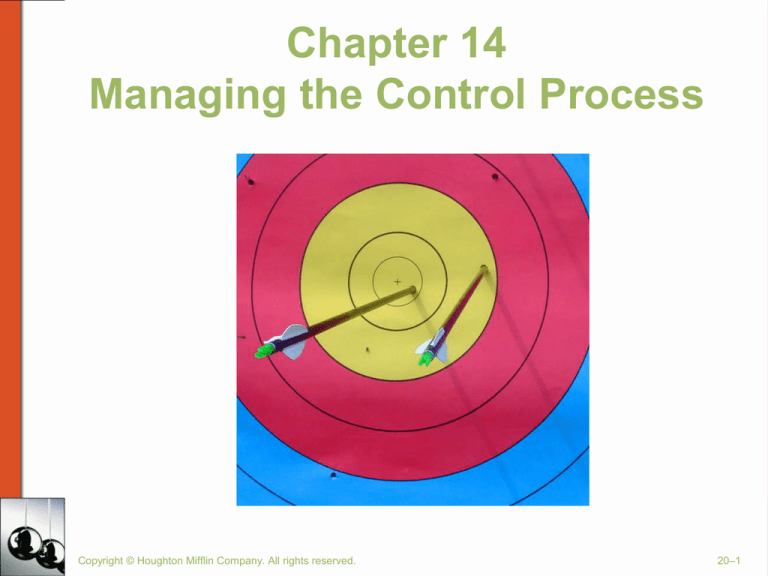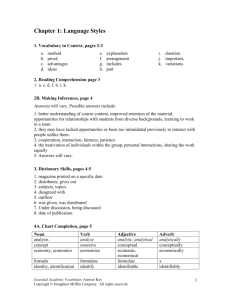
Chapter 14
Managing the Control Process
Copyright © Houghton Mifflin Company. All rights reserved.
20–1
Controlling
Regulating ongoing activities
to so that performance remains
within acceptable
limits and goals
are achieved.
Copyright © Houghton Mifflin Company. All rights reserved.
20–2
Functions of Management
Planning Organizing Directing Controlling
Review and Modify
Copyright © Houghton Mifflin Company. All rights reserved.
20–3
Purpose of Control
•
•
•
•
Adapt to environmental change
Limit the accumulation of error
Coping with organizational complexity
Minimize costs
Copyright © Houghton Mifflin Company. All rights reserved.
20–4
Areas of Control
•Physical resources—inventory
management, quality control, and equipment
control.
•Human resources—selection and
placement, training and development,
performance appraisal, and compensation.
•Information resources—sales and
marketing forecasts, environmental analysis,
public relations, production scheduling, and
economic forecasting.
•Financial resources—managing capital
funds and cash flow, collection and payment
of debts.
Copyright © Houghton Mifflin Company. All rights reserved.
20–5
The Control Function
1. Set
standards
4. Take
corrective
action
2. Monitor
actual
performance
3. Compare
actual
performance
against standard
Copyright © Houghton Mifflin Company. All rights reserved.
20–6
-Establish standards
•Control standard—a target against which subsequent
performance will be compared. Set during the Planning function.
Should be expressed in measurable terms and consistent with
organizational goals.
-Measure performance
•Performance measurement is a constant, ongoing process.
•Performance measures must be valid indicators (e.g., sales,
costs, units produced) of performance.
-Compare performance against standards
•
Define the permissible deviation from the performance
standard.
-Consider corrective action
1. Maintain the status quo (do nothing).
2. Correct the deviation to bring operations into compliance with
the standard.
3. Change the standard if it was set too high or too low.
Copyright © Houghton Mifflin Company. All rights reserved.
20–7
Forms of Operations Control
Copyright © Houghton Mifflin Company. All rights reserved.
20–8
Financial Control
Control of financial resources as they:
•Flow into the organization revenues
•Are held by the organization as working
capital, retained earnings
•Flow out of the organization as payment of
expenses
Copyright © Houghton Mifflin Company. All rights reserved.
20–9
Budgetary Control
–Budgets
•May be established at any organizational level.
•Are typically for one year or less.
•May be expressed in financial terms, units of output, or other
quantifiable factors.
–Purposes of budgets
•Help managers coordinate resources and projects.
•Help define the established standards for control.
•Provide guidelines about the organization’s resources and
expectations.
•Enable the organization to evaluate the performance of
managers and organizational units.
Copyright © Houghton Mifflin Company. All rights reserved.
20–10
Copyright © Houghton Mifflin Company. All rights reserved.
20–11
Other Tools for Financial Control
•Financial Statements
–Financial statement
•A profile of some aspect of an organization’s financial
circumstances.
–Balance sheet
•A listing of assets (current and fixed), liabilities (short- and
long-term), and stockholders’ equity at a specific point in time
(typically, year-ending) that summarizes the financial
condition of the organization.
–Income statement
•Summary of financial performance—revenues less expenses
as net income (i.e., profit or loss)—over a period of time,
usually one year.
Copyright © Houghton Mifflin Company. All rights reserved.
20–12
Other Tools for Financial Control
•Ratio Analysis
–The calculation of one or more financial ratios to
assess some aspect of the organization’s financial
health.
•Liquidity ratios
•Debt ratios
•Operating ratios
•Financial Audit
–An independent appraisal of an organization’s
accounting, financial, and operational systems.
•External audits
•Internal audits
Copyright © Houghton Mifflin Company. All rights reserved.
20–13
Characteristics of Effective Control
–Integration with planning
–Flexibility
–Accuracy
–Timeliness
–Objectivity
Copyright © Houghton Mifflin Company. All rights reserved.
20–14
Why Resistance to Control?
Overcontrol
Inappropriate Focus
Rewards for Inefficiency
Too much accountability
To overcome resistance to change…
Make sure your controls have all the characteristics of effective
controls, encourage employee participation, and develop
verification procedures.
Copyright © Houghton Mifflin Company. All rights reserved.
20–15

